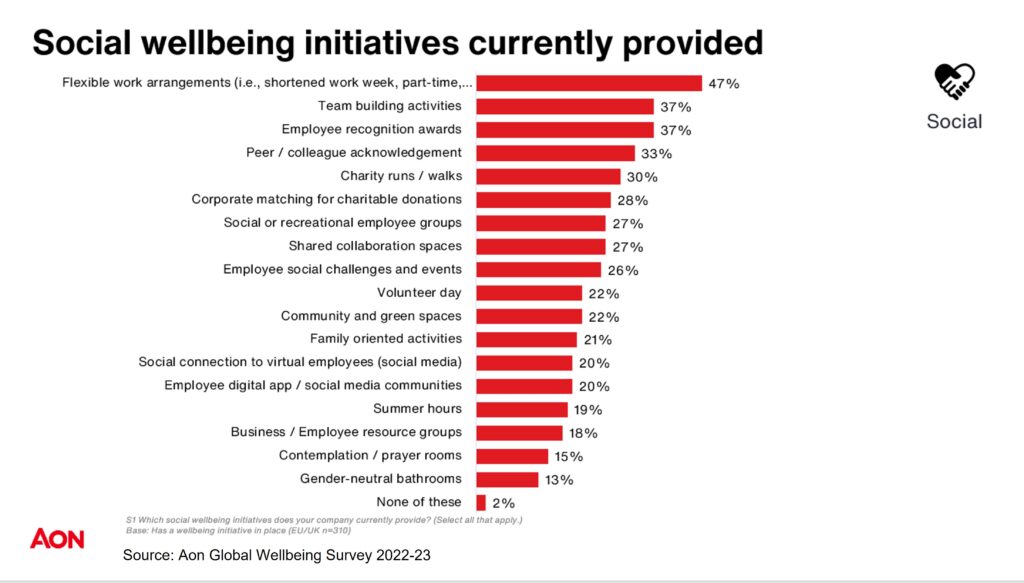‘Tis the season to be social (for many) so we’re focusing this week on social wellbeing. There are many ways you can boost employee social wellbeing, as you can see from the graph below showing the most popular cited in the Aon Global wellbeing Survey 2022-3.

Note on the graph above:
“Be cautious about the first one – flexible working arrangements,” says Letitia Rowlin, Principal Wellbeing Consultant at AON. “Whilst it is generally seen as a good thing, and it may help in terms of giving back time to foster more social connections outside of the workplace, we may have to work harder on maintaining social connections within the workplace especially where operating more remotely and we lose the opportunity for ad hoc social connection in person in the workplace. Making a more conscious effort to connect– perhaps with virtual chats/coffees etc is important.”
And here’s a bit more inspiration and advice on how to implement your social wellbeing strategy:
Get personal and creative with your ideas
As this feature says, the best way to combat loneliness is through a sense of being seen, heard and valued. Employers can help to facilitate this sense at work. For instance, Laura Pearce, Senior HR manager, UK & Ireland, Expedia, gives the creative example of a small but highly effective action which made a big, personal impact:
“When I worked at Secret Escapes we implemented a ‘kindness form’ which we opened once a month and people could say nice things to a colleague, or a thanks, or whatever, and we sent them to everyone anonymously. It was really popular and well received.”
Create conversations
Particularly in the virtual space it’s more challenging to create those casual ‘watercooler’ moments where colleagues get to know each other naturally. But as Mimi Nicklin, Founder of Empathy Everywhere says, even five minutes of social interaction online can make a difference in team relationships and camaraderie.
“Creating virtual conversations or informal ‘chat rooms’, where team members can chat about anything from how their weekends went to the latest news, can help to recreate that sense of casual social connection,” she says.
Alternatively, even building in time to talk informally at the beginning of a meeting can be beneficial, with some companies doing this by picking a theme and getting everyone in the team to give their perspective on it.
Team building activities
While they might not be everyone’s cup of tea, there is definitely a place for social activities in the workplace, whether that be virtual or in person and they rank as one of the most popular options in Aon’s survey (37% of employers said they offered them).
On or offline, you could host games, quizzes or team lunches.
“These activities can help to strengthen the social bonds between team members and can make people feel more connected and less alone,” says Nicklin.
Combine social and physical wellbeing
Engineering and construction company BAM UK and Ireland is soon to launch ‘walking clubs’ at its biggest sites and offices, after seeing how successful this idea has been in one of its offices in Ireland, boosting both physical and social wellbeing.
“The primary reason is to get people moving, get fresh air and start looking after their health but there’s a huge social aspect to that too,” says Ruth Pott, Head of Workplace Wellbeing, BAM UK & Ireland. “Our workforce is predominantly male and there’s lots of research that says to get men talking in particular, the shoulder to shoulder approach makes it easier. It also takes the pressure off because attention is focused on the activity.”
The plan is to start with walking clubs and then see if there’s any appetite for running clubs, or other clubs focused around physical activity.
Volunteering boosts the volunteer’s social wellbeing
Volunteering, like activities such as sports events, similarly also takes the pressure off the need to ‘be social’ by giving employees another focus but, at the same time, putting them in situations which can boost their social wellbeing, as well as feeling good about themselves for contributing.
Pott, for example, uses her lunchbreak once a week to visit an elderly lady nearby through a befriending volunteer programme.
“Something as simple as befriending is actually something that potentially makes a really big impact on the volunteer and the person you’re befriending,” she says. “There’s all kinds of other volunteering work that people can do and that gives them the opportunity to meet people in a structured way to start building friendships.”
Help employees meet their career potential
Career coaching and development is part of a person’s social wellbeing. But according to Myra Khanna, CEO of coaching app Sama, simply providing a career plan “isn’t enough”.
She suggests:
- Provide employees with meaningful development tools, including professional coaching, to give them focus, enable goal attainment and support a sense of achievement
- give teams access to relevant courses and accreditations based on their specific needs
- Develop mentorship programmes and cross-functional internal networks to build a sense of community within your organisation
Build social wellbeing into the day to day working life
Rather than have one off larger events aimed at boosting social wellbeing, it’s better to weave it into the fabric of company life (alongside larger social events). That’s because, as Metro Bank’s Head of Engagement and Inclusion Khushboo Patel says, we “often don’t know that our social wellbeing is poor until crisis mode hits”. To avoid this happening she suggests “making time in everyday life to connect and do what works for you and your social battery”.
Communicate regularly
Especially if you work in a hybrid working team, it can be easy to feel disconnected from your colleagues.
You can overcome this through “regular communication, such as team check-ins, video updates from management, and open forums where employees can share their thoughts and ideas can help to keep everyone centrally connected,” says Nicklin.
Khanna adds:
“Ensure your communication is inclusive and accessible to all team members. Think: subtitles on videos, translations in emails, accessibility in colours and fonts.”
Ask your employees how you are doing on the social front
“Companies should be open to having an honest and open conversation with their employees and listen to thoughts about their work practices. This is the only way a business can really assess where their employees are at and how they can support them where they want to be,” says Jane Bradshaw Jones, HR Business Partner, AdviserPlus.
Khanna agrees adding:
“Seek active feedback from employees on their wellbeing and mindsets, and remember there is no one-size-fits-all when it comes to culture.”
Mind the introverts
Introverts might gravitate more towards opting out of social events but bear in mind that, as Sophie Bryan, Founder of culture consultancy Ordinarily Different, says:
“While many introverts might initially love the idea of minimal interactions in their workday, the reality is that limited social interactions can lead to a lessened sense of belonging with a team, where potential friendships that might flourish in an office environment may not happen in a remote setting.”
So, line managers might need to encourage them to look after their social wellbeing and find ways that they like keeping in touch regularly.












